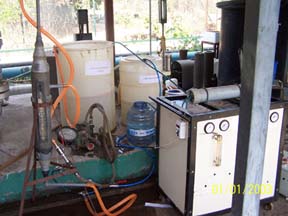

The Technology provides a UF membrane assisted oxidation process for removal of iron from ground/ surface water and makes it safe for drinking purposes. It is a simple, cost effective process adaptable at both domestic and community level and is capable of dealing with high levels of iron contamination. It delivers crystal clear water free of bio-contaminants, turbidity and iron contaminants and operates on very low pressure.
The UF membrane technology at both domestic and community level is separately available for transfer from BARC.
Iron is one of the most plentiful resources found in the earth's crust. Rainfall seeping through the soil dissolves iron in the earth's surface and carries it into almost all kinds of natural water supply, including well water. Besides, iron may also enter drinking water through rusted pipes carrying this water.
Iron is not considered hazardous to human health in moderate levels. In fact, iron is essential for good health because it facilitates transportation of oxygen in blood. However, when the level of iron in water exceeds 0.3 mg/l (ppm) limit, people experience red, brown, or yellow staining of laundry, glassware, dishes and household fixtures such as bathtubs and sinks. The water may also have a metallic taste and an offensive odour. Consumption of water with excess iron causes constipation accompanied by other physiological disorders. As per Department of Natural Resources (DNR), iron is considered a secondary or "aesthetic" contaminant. Present recommended limit for iron in water, 0.3 mg/l (ppm), is based on taste and appearance rather than on any detrimental health effect.
UF membrane assisted oxidation process for removal of iron from ground/ surface water makes it safe for drinking purposes. It is a simple, cost effective, process adaptable at both domestic and community level and is capable of dealing with high levels of iron contamination.
The technologies of UF membrane device used in this process are already available at domestic level (Dead-end element type) and at community level (Back washable flow element type) as separate technologies with Bhabha Atomic Research Centre (BARC). Alternately, these devices can also be procured directly from manufacturers who are manufacturing and marketing these devices in various capacities and configurations as BARC's licensees.
Iron is one of the most plentiful resources found in the earth's crust. Rainfall seeping through the soil dissolves iron in the earth's surface and carries it into almost all kinds of natural water supply, including well water. Besides, iron may also enter drinking water through rusted pipes carrying this water.
Iron is not considered hazardous to human health in moderate levels. In fact, iron is essential for good health because it facilitates transportation of oxygen in blood. However, when the level of iron in water exceeds 0.3 mg/l (ppm) limit, people experience red, brown, or yellow staining of laundry, glassware, dishes and household fixtures such as bathtubs and sinks. The water may also have a metallic taste and an offensive odour. Consumption of water with excess iron causes constipation accompanied by other physiological disorders. As per the Department of Natural Resources (DNR), iron is considered a secondary or an "aesthetic" contaminant. Present recommended limit for iron in water, 0.3 mg/l (ppm), is based on taste and appearance rather than on any detrimental health effect.
UF membrane assisted oxidation process for removal of iron from ground/ surface water makes it safe for drinking purposes. It is simple, cost effective, adaptable at both domestic as well we community level and is capable of removing high levels of iron.
The technologies of UF membrane device used in the process are already available as separate technologies at domestic level (Dead-end element type) and community level (Back washable flow element type) with Bhabha Atomic Research Centre (BARC). Alternately, these devices may also be procured directly from manufacturers who are manufacturing and marketing these devices in various capacities and configurations as BARC's licensees.
RAW MATERIALS
INFRASTRUCTURE

